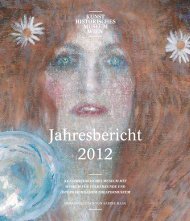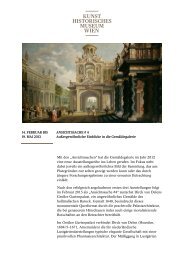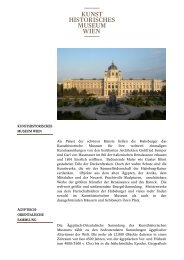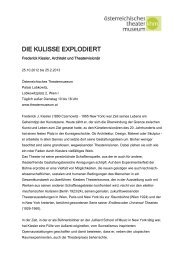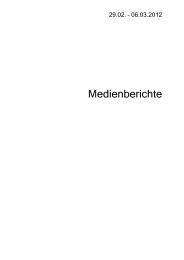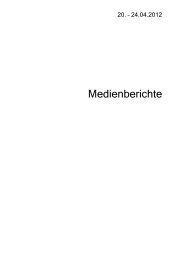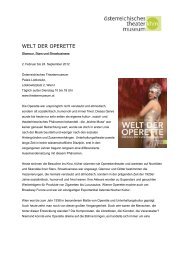Jahresbericht 2011 - Presse - Kunsthistorisches Museum Wien
Jahresbericht 2011 - Presse - Kunsthistorisches Museum Wien
Jahresbericht 2011 - Presse - Kunsthistorisches Museum Wien
Erfolgreiche ePaper selbst erstellen
Machen Sie aus Ihren PDF Publikationen ein blätterbares Flipbook mit unserer einzigartigen Google optimierten e-Paper Software.
188<br />
khm, museum oF ethnology and austrIan theatre museum, <strong>2011</strong><br />
ambras castle<br />
in addition to the annual exhibition programme, from<br />
January onwards a project entitled Das Eigene & das<br />
Fremde (“Familiar and Foreign”) was organised in<br />
Ambras castle involving children, young people and<br />
adults with or without a migration background. The<br />
Primary School in Hall, Unterer Stadtplatz, the BrG<br />
Adolf Pichler Platz, the BFi, the innsbruck refugee centre<br />
and the Ankyra Association participated. Topics such as<br />
foreignness, integration, cultural exchange etc. were<br />
studied and explored in the form of workshops and<br />
in direct analysis with the collections in Ambras<br />
(foreign/exotic objects in the collection of Sculpture and<br />
Decorative Arts; war-related items/spoils of war in the<br />
armoury). Artistic works created by the participants<br />
during the project were presented in an exhibition.<br />
lIbrary<br />
in cooperation with the Sonnberg prison the project<br />
“Sonnberg i“ was continued with the aim of supporting<br />
the re-socialisation of fringe groups by involving them in<br />
book-binding as well as simple conservation work. As<br />
part of the preparations for the Gustav Klimt exhibition<br />
in 2012, external restoration work was carried out on<br />
six of Gustav Klimt’s transfer sketches for the spandrel<br />
and intercolumniation pictures on the staircase of the<br />
<strong>Kunsthistorisches</strong> <strong>Museum</strong>.<br />
archIVes<br />
Besides dealing with current enquiries and the regular<br />
participation in the jours fixes of the commission for<br />
Provenience research, research related to Jan Vermeer<br />
van Delft’s The Artist’s Studio was brought to a close.<br />
The committee of the commission for Provenience<br />
research decided in its meeting on 18 March <strong>2011</strong> not<br />
to recommend returning the painting. A partial autopsy<br />
was made in the <strong>Kunsthistorisches</strong> <strong>Museum</strong>’s library of<br />
the books acquired between 1933 and 1945 so that a<br />
workshop report could be compiled. in April <strong>2011</strong> a<br />
presentation of facts concerning objects from the<br />
Valentine Springer collection and in December <strong>2011</strong> a<br />
supplementary dossier on objects from the Siegfried<br />
Fuchs collection was submitted to the commission for<br />
Provenience research. in the summer of <strong>2011</strong> the two<br />
researchers on provenience began to work on systematic<br />
provenience research in the collection of Sculpture and<br />
Decorative Arts.<br />
scIentIFIc laboratory<br />
in 2010 permission was given for the mobile XrF (X-ray<br />
fluorescence) spectrometer to go into service and so in<br />
<strong>2011</strong> studies were able to go ahead in full. After rapidly<br />
overcoming some fundamental problems in the analysis<br />
or in the evaluation of the spectres, the first quantitative<br />
analyses were possible. Attention was focused on the<br />
analysis of glass and enamel – materials which because<br />
of the high percentage of light elements (na – Si), whose<br />
signals are strongly absorbed in the air – are difficult to<br />
analyse as a whole. By using the vacuum chamber of the<br />
XrF spectrometer PArT ii (Portable Art Analyser) it is<br />
however possible, with the relevant reading times, to<br />
detect sodium, at least down to an na o percentage<br />
2<br />
of 13 %. Two X-ray tubes, molybdenum (Mo) and chromium<br />
(cr) are available for the analyses.<br />
museum oF ethnology<br />
in <strong>2011</strong> a decision was taken concerning the new<br />
appointment of a director for the <strong>Museum</strong> of ethnology<br />
from May 2012, thus paving the way for a new orientation<br />
of this important museum. The decision was made<br />
after it finally became clear that the <strong>Museum</strong> of Folklore<br />
had no intention of joining the <strong>Museum</strong> Group. on the<br />
basis of knowledge gained from the discussion process<br />
lasting several years concerning the <strong>Museum</strong> Neu, the<br />
complete re-furbishing of the public collection and a<br />
new positioning as regards content have highest priority<br />
here.<br />
in <strong>2011</strong> the <strong>Museum</strong> of ethnology also organised a series<br />
of outstanding exhibitions which were remarkable<br />
because they contained hardly any loans but primarily<br />
displayed the museum’s own objects. This again showed<br />
the impressive variety and richness of the collection.<br />
113 events of a very varied nature, ranging from guided<br />
tours by experts, lectures, discussions about objects,<br />
book presentations, as well as evenings of music and<br />
dance performances, and also several workshops were<br />
organised which in total were attended by almost<br />
5000 visitors. in December, in cooperation with the<br />
organisation Médecins sans Frontières, the touching multimedia<br />
installation Starved for Attention was presented.<br />
The education programme was also intensified in <strong>2011</strong>.<br />
in cooperation with the Department of the Didactics of<br />
Political education at the University of Vienna this included<br />
further education in the form of a workshop on the subject<br />
<strong>Museum</strong> as a place of learning, and in cooperation<br />
with icoM Austria, a lecture by the renowned educationalist<br />
George Hein.<br />
one of the highlights of the academic events organised<br />
during the year was the conference held in September,<br />
True ‘Culture’? Cultural Heritage, Re-vitalisation and the<br />
Renaissance of the Idea of Culture.<br />
The <strong>Museum</strong> of ethnology fosters increasingly intensively<br />
the international exchange with other museums and<br />
is committed to several projects subsidised by the eU,<br />
including RIME (international network of ethnographic<br />
museums), which deals with future perspectives of<br />
ethnology museums. Moreover, together with the<br />
colleagues from the Museo nazionale Preistorico<br />
etnografico Luigi Pigorini in rome, the Musée du quai<br />
Branly in Paris and the royal <strong>Museum</strong> of Africa in<br />
Tervuren, Belgium, another eU project was successfully<br />
started: ReadMe, in which the curators of the museums,<br />
including the active participation of representatives of<br />
migrant communities, critically analyse the inclusion of<br />
the subject of migration in ethnographic museum work.<br />
At the end of the year an eU-sponsored training<br />
programme (ICD – MUSE) was introduced, which is<br />
taken care of by the <strong>Museum</strong> of Foundational Works<br />
in Ankara and which is concerned with the expert<br />
exchange of information and transfer of knowledge<br />
between the partner museums in romania and Turkey as<br />
well as the <strong>Museum</strong> of ethnology.<br />
The cooperation with museums and communities in the<br />
countries of origin of the collections was continued.<br />
one highlight was the loan to the Te Papa Tongarewa<br />
<strong>Museum</strong> in new Zealand for an exhibition organised<br />
together with the Maori confederation Tainui Waka<br />
Alliance in the form of a historically valuable Maori<br />
chieftain head-dress. intensive progress was also made<br />
in the bi-national research and conservation project on<br />
the ancient Mexican feather headdress. on a trip to Brazil<br />
contacts with the Warí and Kanoê were intensified. cooperation<br />
with the nigerian museums was realised in<br />
support for the production of the African Lace exhibition<br />
in Lagos. Discussions on the shared cultural heritage<br />
in the context of the Benin art treasures were also<br />
continued this year in the Berlin <strong>Museum</strong> of ethnology.<br />
sub-saharan aFrIca<br />
Thanks to John D. Marshall’s generous support it was<br />
possible to purchase for the museum a Korobla helmet<br />
mask from the ivory coast. its zoomorphic shape – with<br />
the mouth of a crocodile, the tusks of a warthog, the<br />
ears of a hyena as well as the chameleon figure on the<br />
crown – refers to animals which play an important role in<br />
the myths surrounding the foundation of the Senufo.<br />
The Korobla type of mask was created to banish negative<br />
forces as a response to the social upheavals in the course<br />
of colonialism and the founding of the state in the<br />
densely populated northern part of ivory coast which is<br />
organised on a peasant structure.<br />
north aFrIca, mIddle east, central asIa<br />
and sIberIa<br />
in <strong>2011</strong> activity was focused on planning, designing and<br />
supervising the special exhibition Wald / Baum / Mensch.<br />
As a contribution to the “international Year of the<br />
Forest”, in three thematic axes (the forest of fantasy/the<br />
disenchanted forest/the maltreated forest) and by means<br />
of the objects on display, this exhibition aimed to<br />
approach the phenomenon of the forest and everything<br />
related to it.<br />
east asIa<br />
in 2010 the department of east Asia in the <strong>Museum</strong><br />
of ethnology received a collection from the legacy of<br />
eva Sock; she had inherited it from her uncle, Dr. Anton<br />
Walk (1901–1933), who spent the last years of his life<br />
in Shanghai.<br />
The collection comprises 21 objects, and the way they<br />
are compiled is typical for a collection created at the<br />
beginning of the 20th century. objects made of jade,<br />
varnish, cloisonné, porcelain and bronze are to be seen.<br />
Particularly outstanding is the food bowl fu from the<br />
Bronze Age, whose companion piece is in a museum in<br />
the Peoples’ republic of china.<br />
south and south-east asIa, hImalayas<br />
Work was carried out on the research project Mongolic<br />
Ethnographica of the Austrian Collector Hans Leder<br />
in European <strong>Museum</strong>s (in the context of the grant<br />
programme forMuse) financed by the Federal Ministry of<br />
Science and research. in connection with field research<br />
in nagaland, attempts were made on the basis of photos<br />
of objects from the naga collection of the museum<br />
to investigate their significance in the context of the<br />
traditional culture. During the course of this journey<br />
an extensive collection was set up about the cultural<br />
transformation of the naga.




